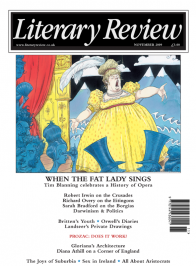Paul Johnson
The Highland Rembrandt
Edwin Landseer: The Private Drawings
By Richard Ormond
Unicorn Press 192pp £25
Sir Edwin Landseer (1802–73) was in his day the most popular painter in Britain, and the most eccentric. His father, who figures frequently in the Farington Diaries, was the leading London engraver, always soliciting help in getting other engravers made full members of the Royal Academy. Two of his sons became engravers and two of his daughters miniaturists. But it was Edwin, the youngest son, who was the prodigy. Aged eleven, he won a Society of Arts silver palette for his drawing of a spaniel. He exhibited at the RA two years later, was elected an associate member of the Royal Academy aged twenty-four and a full member before he was thirty, and in due course was offered the presidency, which he declined. His prodigious skill in depicting animals, especially dogs, horses and deer (he painted fur even more skilfully than Dürer) secured him a lucrative trade among the aristocracy, and he was Queen Victoria’s favourite painter. Engravings of his works made him a rich man. He enlarged his studio-house at No 1 St John’s Wood Road until it could accommodate the largest animals, including giraffes. While he was engaged on his most famous commission, the bronze beasts in Trafalgar Square, his butler delighted to announce, after breakfast, ‘Sir Edwin, the lion has arrived.’ (The story that, on the first occasion, he asked: ‘Did you order a lion, sir?’ is apocryphal.) The elderly and docile creature came from the zoo in a furniture van, attended by two keepers.
In 1824 Landseer discovered the Highlands, and thereafter he spent most of the autumn each year visiting the vast sporting estates then coming into fashion. He was welcome at many but his favourite was Glenfeshie, a beautiful tract on the edge of the Cairngorms. There, the Duchess of

Sign Up to our newsletter
Receive free articles, highlights from the archive, news, details of prizes, and much more.@Lit_Review
Follow Literary Review on Twitter
Twitter Feed
It wasn’t until 1825 that Pepys’s diary became available for the first time. How it was eventually decrypted and published is a story of subterfuge and duplicity.
Kate Loveman tells the tale.
Kate Loveman - Publishing Pepys
Kate Loveman: Publishing Pepys
literaryreview.co.uk
Arthur Christopher Benson was a pillar of the Edwardian establishment. He was supremely well connected. As his newly published diaries reveal, he was also riotously indiscreet.
Piers Brendon compares Benson’s journals to others from the 20th century.
Piers Brendon - Land of Dopes & Tories
Piers Brendon: Land of Dopes & Tories - The Benson Diaries: Selections from the Diary of Arthur Christopher Benson by Eamon Duffy & Ronald Hyam (edd)
literaryreview.co.uk
Of the siblings Gwen and Augustus John, it is Augustus who has commanded most attention from collectors and connoisseurs.
Was he really the finer artist, asks Tanya Harrod, or is it time Gwen emerged from her brother’s shadow?
Tanya Harrod - Cut from the Same Canvas
Tanya Harrod: Cut from the Same Canvas - Artists, Siblings, Visionaries: The Lives and Loves of Gwen and Augustus John by Judith Mackrell
literaryreview.co.uk